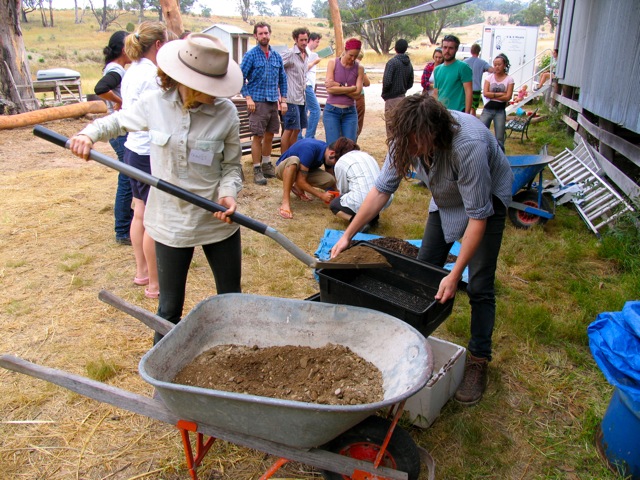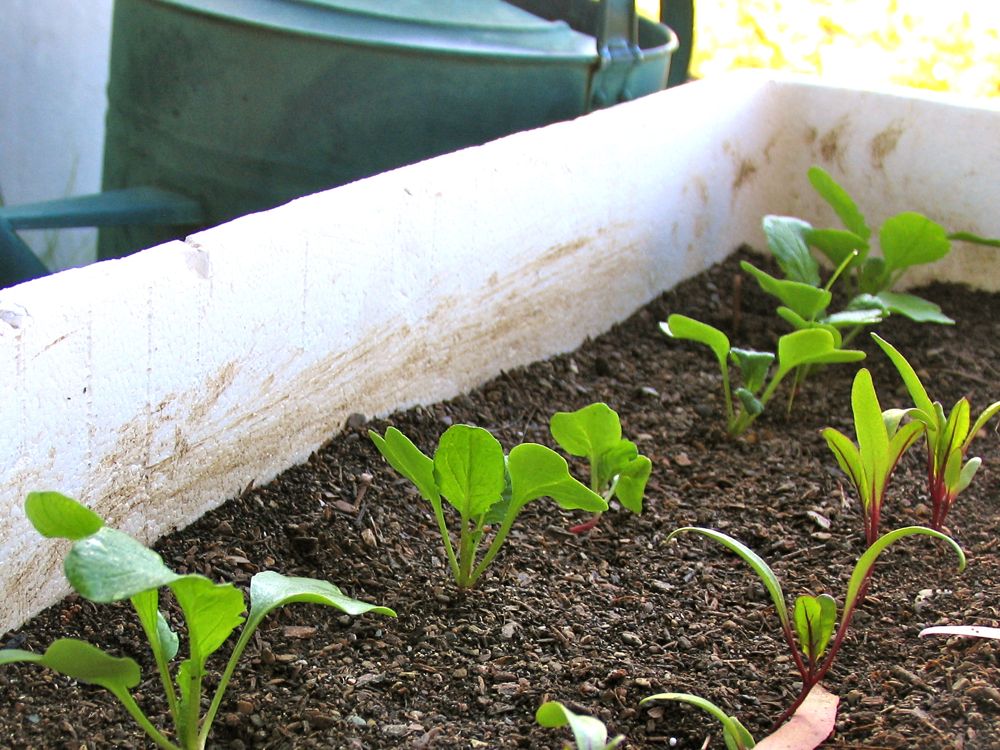

A wicking box is a contained, portable way to grow vegies (or anything else) with very little water. Essentially, it’s a wicking bed in miniature. Very cool.
Wicking boxes can be used either as part of an intensive water-wise growing system, or just a good way to keep those herbs alive that you usually forget to water. And you can make one yourself out of junk for next to nothing!
A wicking box functions the same way as a wicking bed (see how to make a wicking bed for the full rundown).
Any wicking system of this kind relies on a couple of things: a contained bottom reserviour filled with gravel, a watering pipe, and a container to hold the soil and plants above. In a wicking box, this system is all in the one vessel.
A wicking bed works by filling the gravel reservoir with water via the watering pipe, which then ‘wicks’ up into the soil above, watering the plant roots within that soil. Because the plants are watered from below (and heavily mulched on top of the soil), a wicking system is very water efficient and reduces heat and water stress in the plants, as there is always water available at their root zone.
 Sieving soil for the wicking boxes
Sieving soil for the wicking boxes
At our last PDC at Milkwood Farm, Adam Kennedy rocked up to do some workshops with the class. As one of the workshops, he made some wicking boxes for some herbs. Three months later, those herbs are still going strong. I wouldn’t say we forget to water them, it’s more that we know they’re in good hands…
How to make a wicking box: materials
Here’s what we used. You could substitute any of these materials for something that would do a similar job:
- A suitable box (we used styrofoam fruit boxes)
- Gravel
- Plastic pipe
- Hessian sack cloth
- Electric drill
- Topsoil
- Plants
- Mulch
How to make a wicking box: method
- After cleaning the box, we bored two holes in its sides, about 1/3 from the bottom. These are overflow holes so that if the reservoir floods the soil doesn’t become waterlogged.
- We cut the pipe to size so that, when standing it up in the box, it was about 15cm above where the final soil line would be. Then we drilled a bunch of holes in the bottom third of the pipe. This will be how the water gets into the reservoir.
- Standing the pipe straight up, we filled the box 1/3 full with washed gravel
- We laid in a piece of hessian sack, cut to size to fit in the box. This acts as a permeable barrier between the water reservoir and the soil.
- Next we added a seived mix of soil and compost to 10 cm below the top of the box.
- Then we planted some herbs.
- Lastly we filled the reservoir with a hose down the pipe. Once water started dribbling out the outlet holes we knew the reservoir was full. Then we gave the soil a light watering to settle the new herbs in, mulched the top, and stood back.
- At any time you can check the water level in the reservoir by looking down the pipe. Once it gets a little low, top it up and off you go again!
Verdict
3 months later, both these wicking boxes are growing strong and full of herbs (they’re not bouncing out of their boxes, but that’s the growth cycle at this time of year at our farm – it’s slowdown time).
We’ve also sowed a bunch of small seedlings into the third wicking box, and they are growing well also. So I would say that wicking boxes are a little winner of a DIY project, all said and done!
I should add that here are many variations on this idea, both in what you could use for a vessel, and the exact ratios of gravel to soil, permeable membranes, etc etc etc. But the idea is solid, and it works.


Some wicking box resources:
- Wicking boxes by Scarecrow
- Wicking worm bed boxes (say that four times fast)
Some wicking bed resources:
- How to make a wicking bed – at Milkwood.net
- Full photoset of the above wicking bed construction – in Alice Springs
- Wicking beds from around the world – a couple of examples
- Ecofilms wicking bed – powered by fish water from their aquaponics setup
- Maireid’s wicking bed – great wicking bed photos
Many thanks to Adam Kennedy for his experimenting and helpful instruction on how to make wicking boxes.













I have a friend building a wicking bed. She was explaining that the gravel has to be very fine in order to produce a wicking effect. If the gavel is to large the water just sits at the bottom and goes stagnant. In fact I think she is using diced sugar cane instead of gravel. Have you found the size of the gravel to be a problem?
Hey Jason –
No, we’ve found it to be okay so far, as have others we know… Hmm! Interesting though. Sugar cane would break down over time… not that that’s a bad thing per se, but you would lose the wicking effect eventually I would think? I wonder…
I have built a couple of these – they are fantastic!
However in one box the roots grew right through the bottom and so water is lost through the holes making this particular box useless. Another is showing signs of this starting. Have you encountered this problem? All i can think to do is line the bottom of the box with plastic, but i wonder if this would leech into the water…
You can raise the wick boxes on stumps, have two rows then join the two rows with an arch of steel reinforcement the type used in house concrete slabs this can then be closed off at each end with a gate.and the whole arch tunnel covered in shade cloth or plastic to create a wicker box greenhouse. Thanks bernard melbourne australia.
Hallo Kirsten and Milkwoodies, We have organised our galvanised raised garden beds and now we are ready to turn them in to wicking beds before planting them out in Spring. They are 3000×1000 oval. Most of the advice we have is to use scoria rather than washed gravel. What would you recommend?
Hey well done 🙂 – well actually, we now have come over to the side of filling with soil all the way to the bottom – yes, the bottom of the soil is waterlogged, but the fine particle size means that the ‘wick’ to the soil above the outlet is so much better that it’s worth it… just another option for you! But I would say whatever you can get hold of re gravel or scoria – scoria will hold more life in it due to its open structure though… good luck!
Hallo Kirsten and Milkwoodies, What would you recommend for a soil mix for our wicking beds. We have done a lot of research and have come up with this recipe: loam 50%, mushroom compost 25%, cow manure 25%. mushroom compost. Thank you for your suggestions and advice.